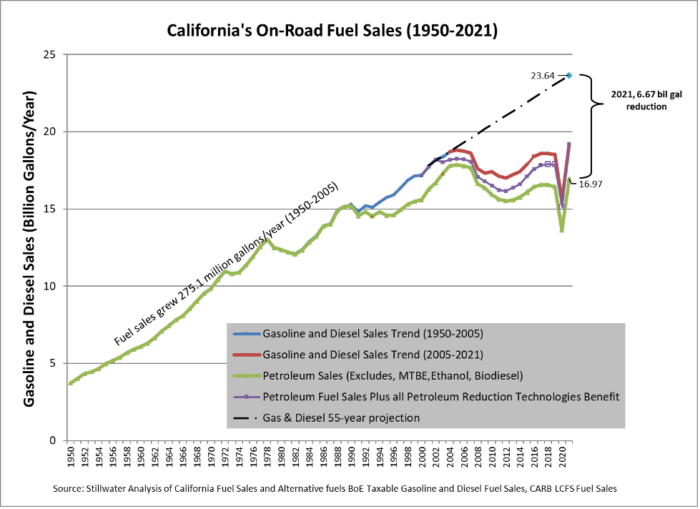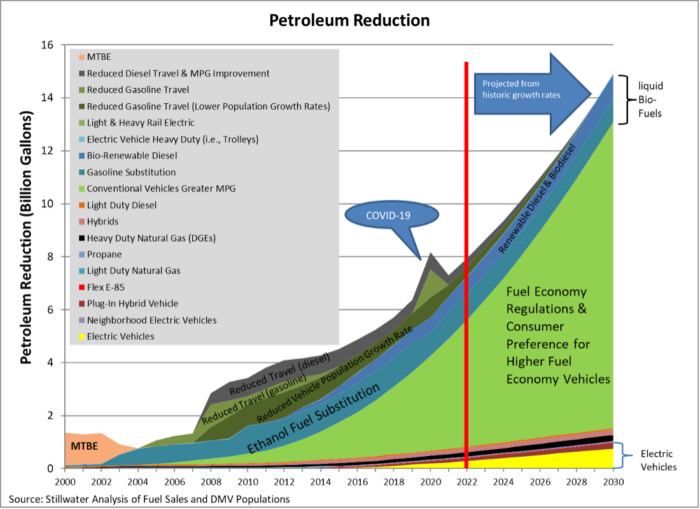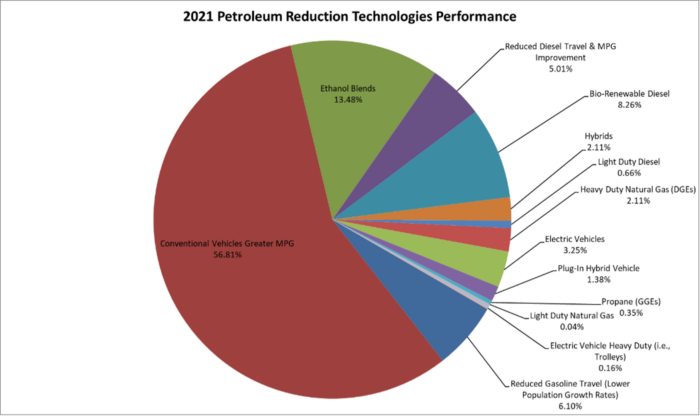Electric Vehicles: How California is helping to reduce petroleum demand in the face of the Ukraine conflict
Link to article: https://stillwaterassociates.com/electric-vehicles-how-california-is-helping-to-reduce-petroleum-demand-in-the-face-of-the-ukraine-conflict/
May 11, 2022
By Gary Yowell
The Biden Administration[1] has been promoting EVs as a key federal strategy to address the current petroleum dilemma brought about by the Russian invasion of Ukraine. Using California, the most proactive EV state in the country as a guide, we can examine the effectiveness of EVs in reducing petroleum use.
Analysis
California’s growing gasoline and diesel fuel sales from 1950 to the present – shown in Figure 1 below – provide a foundation from which to analyze factors that reduce petroleum fuel sales. Projecting forward the trend line from 1950 to 2005 – shown in the broken black line in the figure below – and contrasting that projection with actual fuel sales indicates that by 2021 there was a 6.67-billion-gallon reduction in petroleum fuel use compared to the historical trendline. So, what are the key factors that created this petroleum fuel sales decline?
Figure 1. Fuel Sales Trend and Petroleum Reduction Since 2004

We examined 15 factors that contributed to reducing petroleum sales. This analysis was done using fuel sales data from California Board of Equalization, now called California Department of Tax and Fees Administration, the California Air Resources Board’s Low Carbon Fuel Sales data, Department of Motor Vehicles‘ vehicle registrations, California Bureau of Automotive Repair’s vehicle miles traveled data, the U.S. Environmental Protection Agency’s fuel economy data and guides, the U.S. Energy Commission’s reported vehicle sales, the U.S. Department of Finance’s human populations data, and utilities’ compressed natural gas sales.
Results
Figure 2 below displays the last 21 years of petroleum reductions in California and reduction projections through 2030. As can be seen, the greatest factor reducing fuel use is the consumer shift to buying higher fuel economy cars as gasoline prices rose above $2.00 per gallon in 2003. This factor was enhanced after 2011 when manufacturers responded with higher fuel economy vehicle offerings and again with subsequent higher fuel economy regulations. Higher gasoline prices from 2004 through 2014 suppressed driving and ultimately contributed to the 2009-2010 recession. Demand reduction followed the recession to 2014, along with the COVID-19 pandemic, which played a dramatic but temporary role in the reduction of fuel use.
Stillwater Associates estimates that in 2021, EVs reduced 238 million gallons of gasoline, representing 3.5% of all gasoline and diesel reductions. Combined, EVs and gasoline-plug-in hybrids reduced 340 million gallons (or 5% of the total reductions) for the year. Projecting into the future, EVs are expected to reduce 755 million gallons, representing 5% of the total petroleum reduction in 2030. Combining EVs with gasoline-plug-in hybrids could reduce 960 million gallons, or 6.35% of the total expected petroleum reduction by 2030.
Figure 2. Historic Factors that Reduced Petroleum Fuel Use and their Projection to 2030

Figure 3 provides a breakout of the 15 factors reducing petroleum use in California, we suspect this is similar for the rest of the nation, except the EV contribution for the U.S. will be less than half as much as California’s.
Figure 3. Percent of Petroleum Reduction Factors in 2021 in California

Source: Stillwater Associates Analysis
Federal agencies have several direct control authorities that can (over several years) reduce the growth of petroleum use, such as: mandating higher fuel economy regulations, incentivizing EVs, and expanding biofuels use. As the evidence shows, petroleum reduction policy recommendations restricted to EVs and gasoline-plug-in hybrids are insufficient in magnitude to the urgent task discussed for the Ukraine / Russian conflict. In fact, the petroleum reduction benefit of EVs and gasoline plug-in hybrids combined is overwhelmed by the increased fuel demand. Higher fuel economy vehicle policies along with higher gasoline prices are reducing petroleum use 60%. Biofuel policies promoting ethanol, biodiesel, and renewable diesel are reducing petroleum fuel use 23%.
[1] Energy Secretary Jennifer Granholm, Comments May 2022.
